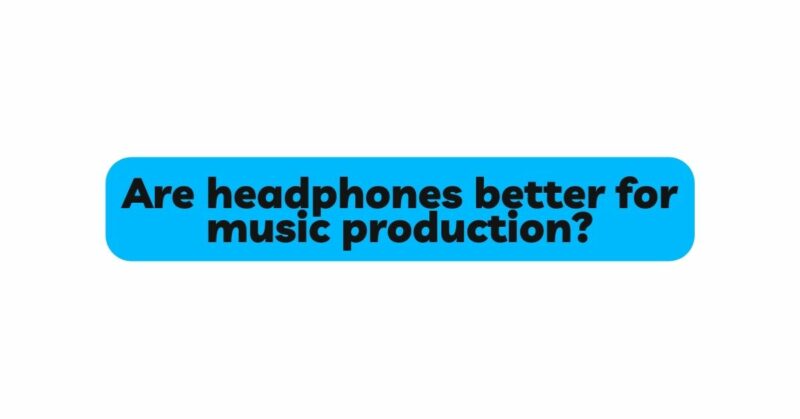In the realm of music production, the choice between studio monitors and headphones has been a long-standing debate. Both tools serve as indispensable components of a music producer’s arsenal, providing a different listening experience and serving unique purposes. In this article, we will delve into the advantages and disadvantages of using headphones for music production, exploring their impact on accuracy, versatility, comfort, and ultimately, the quality of the final product.
Section 1: The Accuracy Conundrum
One of the primary concerns when it comes to using headphones for music production is accuracy. Unlike studio monitors that provide a more natural and room-filling sound, headphones offer a more isolated auditory experience. This isolation can be beneficial in certain situations, allowing producers to focus on minute details and intricacies within the mix. However, the lack of room acoustics can sometimes lead to skewed judgments regarding spatial elements and overall tonal balance.
To address this concern, advancements in headphone technology have led to the development of “studio reference” headphones. These headphones attempt to reproduce sound as neutrally as possible, providing a more accurate representation of the mix. Nevertheless, the debate regarding the level of accuracy achieved by headphones compared to studio monitors continues to spark discussions in the music production community.
Section 2: Versatility: A Headphone Advantage
One undeniable advantage of using headphones for music production is their versatility. Whether you’re in a professional studio, a home setup, or even on-the-go, headphones provide a portable and practical solution for monitoring and mixing. Producers can work in various environments without being influenced by the surrounding acoustics, making headphones an excellent choice for those with limited space or the need for a portable setup.
Additionally, using headphones can enhance the workflow during late-night sessions or in shared living spaces where noise isolation is essential. The ability to work without disturbing others allows producers to focus solely on their craft, ultimately leading to more productive sessions and creative breakthroughs.
Section 3: Comfort and Fatigue
The prolonged use of studio monitors can cause listening fatigue due to the sound waves spreading through the air and affecting the ears for extended periods. In contrast, headphones deliver sound directly to the ears, which can be more comfortable during long sessions. Additionally, modern headphones are designed with padded ear cups and adjustable headbands, further enhancing comfort.
However, prolonged use of headphones can lead to ear fatigue and discomfort as well, especially if the headphones exert pressure on the ears. It is crucial for music producers to take breaks and monitor their listening levels to prevent any potential hearing damage or discomfort.
Section 4: Headphones and the Art of Mixing
The art of mixing involves achieving a balanced and cohesive sound by adjusting various audio elements, such as volume, panning, and equalization. The choice between headphones and studio monitors can significantly impact the mixing process. Some producers argue that headphones allow them to hear intricate details in the mix that might go unnoticed on studio monitors, helping them create a more precise and polished final product.
On the other hand, headphones might struggle to accurately represent the three-dimensional soundstage present in studio monitor setups. Panning decisions, stereo imaging, and the overall sense of space can be more challenging to gauge with headphones, potentially leading to mix translations issues when played on different systems.
Section 5: Understanding the Impact of Headphone Impedance
Headphone impedance plays a crucial role in determining their compatibility with various audio interfaces and devices. High-impedance headphones require more power to produce a satisfactory volume level, and while they might offer better sound quality, they may not work optimally with all equipment. Conversely, low-impedance headphones are more versatile and can be connected to a broader range of devices, making them more accessible for music production tasks.
Section 6: Mixing for Different Listening Environments
One significant consideration when using headphones for music production is the need to ensure the mix translates well to other playback systems, such as car speakers, home audio setups, or club sound systems. Mixing exclusively on headphones can result in mixes that sound unbalanced or lack appropriate low-end frequencies when played on speakers. This highlights the importance of cross-referencing mixes between headphones and studio monitors to achieve a more accurate representation of the final product.
Conclusion:
In conclusion, the choice between headphones and studio monitors for music production is not a straightforward one. Each option presents distinct advantages and disadvantages that cater to different needs and working environments. Headphones offer portability, isolation, and an opportunity to focus on intricate details, while studio monitors provide a more natural listening experience and aid in mixing for various playback systems.
Ultimately, the ideal approach for music production might involve a combination of both headphones and studio monitors. Producers can leverage the strengths of each tool to create well-balanced and sonically rich mixes. The key lies in understanding the strengths and limitations of both options and finding the right balance to produce music that resonates with listeners, regardless of the playback system they use.


